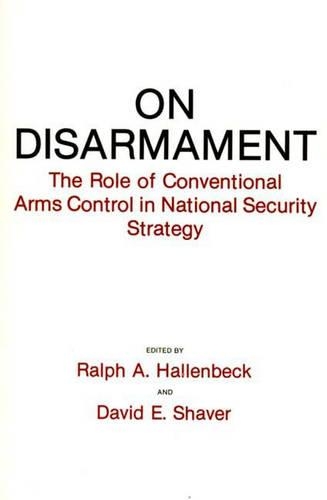
On Disarmament: The Role of Conventional Arms Control in National Security Strategy
(Paperback)
Available Formats
Publishing Details
On Disarmament: The Role of Conventional Arms Control in National Security Strategy
By (Author) Ralph A. Hallenbeck
Edited by David E. Shaver
Bloomsbury Publishing PLC
Praeger Publishers Inc
30th March 1991
United States
Classifications
Tertiary Education
Non Fiction
327.174
Physical Properties
Paperback
256
Description
The Revolution of 1989 propels European arms control initiatives into a new context. This book presents a concise analysis of arms reduction efforts, putting crucial issues back into focus. Unique in its field, this U.S. Army War College text incorporates the work of practitioners, academics, and members of the U.S. negotiating team. It is written for an audience that will use it to make decisions. Within the first five chapters the reader will understand conventional arms control history: objectives, political procedures, and definitional and external strategic issues affecting negotiations. Successive chapters address: the role of partial disarmament; CFE proposals, data, and military implications of a successful agreement; the U.S. Interagency Group process; the High Level Task Force; and updates on both Vienna negotiations. A clear hard-headed text designed for policy makers, it provides a valuable analysis for courses in foreign policy, negotiation, political theory and practice, and public policy. This volume opens with a chronology of conventional arms control events from 1967 to 1990. Chapter 2 offers an academic discussion on how and why we developed the general objectives for ongoing CFE and CSBM negotiations in Vienna. Chapter 3 supplies the political insight necessary to comprehend current negotiations. Conventional arms control issues are presented as mini-historical vignettes in Chapter 4. A chapter follows on definitional disarmament. Three successive chapters describe current proposals and progress in the CFE and CSBM talks. Chapter 9 concerns the post-CFE environment--the authors provide a thought-provoking article on a future nonauthoritarian world which looks beyond our current European fixation. The stage is then set for discussion of post-CFE alternative defense strategies and architecture. In closing, the authors reflect on what the effect of U.S. and NATO forces might be after successful conclusions in CFE and CSBM negotiations. The CFE Mandate, NATO's formal proposals, and the Western CSBM proposal are all appended as well as a glossary of terms.
Author Bio
COLONEL RALPH A. HALLENBECK is Chief of the Army's Conventional Arms Negotiation Division. He has served as Chief of Current Operations, U.S. European Command, Assistant Professor of Political Science at the U.S. Military Academy, Mlitary Adviser to the U.S. Delegation to SALT II and Acting Deputy Assistant Secretary of State for Defense and Arms Control. Colonel Hallenbeck has written extensively on issues of conventional arms control. COLONEL DAVID E. SHAVER is a Strategic Research Analyst with the Strategic Studies Institute at the U.S. Army War College. He is coauthor of Conventional Arms Control in Europe: How to Think about Specialization in NATO. His other books include Force Structures and Flex-Lease. Colonel Shaver currently holds the General Douglas MacArthur Chair of Research at the U.S. Army War College.
